Pacific Southwest Airlines
Pacific Southwest Airlines (PSA) was a regional U.S. airline headquartered in San Diego, California, that operated from 1949 to 1988. It was the first large discount airline in the United States. PSA called itself "The World's Friendliest Airline" and painted a smile on the nose of its airplanes, the PSA Grinningbirds.[1] Opinion L.A. of the Los Angeles Times called PSA "practically the unofficial flag carrier airline of California for almost forty years."[2]
 | |||||||
| |||||||
| Founded | 1949 | ||||||
|---|---|---|---|---|---|---|---|
| Ceased operations | April 9, 1988 (integrated into USAir) | ||||||
| Hubs | |||||||
| Parent company |
| ||||||
| Headquarters | San Diego, California, U.S. | ||||||
| Key people |
| ||||||
The airline initially operated as an intrastate airline wholly within the state of California. This strategy which avoided the steep costs from federal regulation would later serve as the model for Southwest Airlines, doing in Texas what PSA had done in California.[3] After the Airline Deregulation Act of 1978, PSA expanded to cities in other western states, and eventually to several cities in Mexico.
PSA was purchased by USAir (later renamed US Airways) in 1986 and was fully merged into the airline on April 9, 1988. The PSA acquisition gave USAir a network on the West Coast, and at about the same time, USAir also purchased Piedmont Airlines which gave the carrier a network on the East Coast. The combined airline became one of the world's largest. US Airways was acquired by America West Airlines in 2005 in a reverse merger, and the combined airline purchased American Airlines in 2015.
American Airlines Group continues to use the PSA name and trademark for its regional airline subsidiary, PSA Airlines which operates flights on behalf of American Eagle. American Airlines also operates an Airbus A321 (previously an A319) painted in the PSA Grinningbird scheme, to pay tribute to the airline.[4]
History
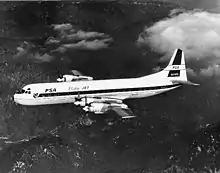
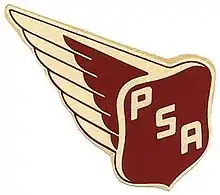
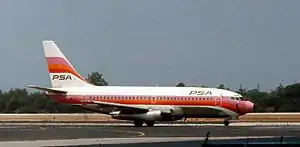
Kenny Friedkin founded the airline in 1949 with a $1,000-a-month leased Douglas DC-3. Friedkin obtained information from a travel agent upon starting the airline due to lessons learned from a failed precursor airline (Friedkin Airlines).[5] The DC-3 began a weekly round trip from San Diego to Oakland via Burbank. Reservations were initially taken at a World War II surplus latrine refitted as a ticket office. In 1951 PSA moved its flights from Oakland to San Francisco International Airport;[6] in late 1955 PSA replaced the DC-3s with two Douglas DC-4s from Capital Airlines, painting rectangles around the windows to make them resemble the Douglas DC-6.
In January 1958 PSA scheduled 37 DC-4s a week Burbank to San Francisco (29 of which originated in San Diego) and four nonstops San Diego to San Francisco; fare from Burbank to San Francisco was $9.99. United Airlines, Western Airlines and TWA then scheduled a total of 241 nonstop flights each week from Los Angeles to San Francisco, plus 49 flights a week from Burbank to San Francisco. About half of these flights by the competition were First Class only ($22.05); the rest carried coach passengers for $13.50 (all fares were subject to 10% federal tax.) Later in 1958 PSA shifted some flights from Burbank to Los Angeles International Airport (LAX); that year it carried 296,000 passengers.
In late 1959 PSA began flying Lockheed L-188 Electras[7] with 92 seats and a six-seat lounge, replacing the 70-seat DC-4s. In 1963 it got its sixth Electra; by then it carried more passengers between the Bay Area and Los Angeles than any other airline. Total PSA passengers climbed from 355,000 in 1959 to 1,305,000 in 1963 and 5,162,000 in 1970.[8]
Boeing 727-114s, Boeing 727-214s, Boeing 737-214s and McDonnell Douglas DC-9-30s replaced the Electras in 1965–70. The May 1965 OAG shows 103 Electras a week Los Angeles (LAX) to San Francisco (SFO), 32 a week Los Angeles to Oakland, 34 a week Burbank to San Francisco and 5 a week San Diego to San Francisco. Schedule time Los Angeles to San Francisco was 60 minutes while Burbank-San Francisco was 55 minutes. (Apparently, the May OAG wasn't up to date; PSA's timetable for 20 April 1965 shows some 727 flights. On Fridays and Sundays the 727 left San Diego in the morning and returned 16 hours later after making seven LAX-SFO-LAX round trips; other days of the week it made six round trips.)
In 1966 PSA started flying to San Jose, and in 1967 to Sacramento Executive Airport (SAC); later that year PSA and other airlines moved to the new Sacramento International Airport (SMF). Ontario was added in 1968 and Long Beach, Fresno and Stockton in 1971–72. In 1967 PSA was finally allowed to use offshore airway V25 to San Diego, despite being an intrastate airline.[9]
In 1974-75 PSA flew two wide-body Lockheed L-1011 TriStars, which were unique in having lower deck seating;[10] they flew Los Angeles-San Francisco and San Diego-Los Angeles-San Francisco. PSA was the only intrastate airline in the U.S. ever to operate wide-body jets. Electras returned in 1975 for flights to Lake Tahoe that ended in 1979 (the Lake Tahoe Airport, in the Sierra Nevada, did not allow scheduled airline jets until the 1980s although Pacific Air Lines briefly flew Boeing 727-100s to Lake Tahoe in 1966.) Major intrastate competitor Air California also flew Electras to Lake Tahoe until 1979–80 but then returned to Lake Tahoe as AirCal with McDonnell Douglas MD-80s and Boeing 737-300s after the jet ban ended. PSA never served Lake Tahoe after retiring its Electras.
After airline deregulation PSA expanded beyond California to Reno, Las Vegas, Salt Lake City, Phoenix, Tucson and Albuquerque. Its first flight beyond California was Oakland to Reno in December 1978. The airline introduced automated ticketing and check-in machines at several airports and briefly flew to Cabo San Lucas in Mexico. When PSA's plan to buy the assets of Braniff International Airways fell through, the airline expanded its network north to Washington, Oregon and Idaho. PSA operated new BAe 146-200s to smaller airports like Eureka, California and Concord, California. PSA held a "Name the Plane" contest, publicized in full-page newspaper advertisements, to name the fleet, with the prize being a private flight for the winner and 99 friends.[11] The winning entry was Smiliner,[12] submitted by Dr. Hugh Jordan of Whittier, California.[13]
| Year | Traffic |
|---|---|
| 1964 | 490 RPMs |
| 1968 | 1232 RPMs |
| 1970 | 1585 RPMs |
| 1973 | 3116 RPKs |
| 1979 | 4527 RPKs |
| 1985 | 5670 RPKs |
In 1987 Western and AirCal were purchased (by Delta Air Lines and American Airlines respectively). An hour after the AirCal deal was announced PSA agreed to merge with USAir, which was completed in 1997. PSA was then in talks with Boeing about acquiring a 757-200. PSA's last flight was on April 8, 1988. The PSA route network slowly disintegrated within USAir and was gone by 2004. Most of the former airline's assets were scrapped or moved to USAir's hubs on the East Coast. PSA's base at San Diego International Airport was gutted and served for a time as that airport's commuter terminal, before being renovated in administrative offices. PSA had planned to become a nationwide carrier; by the time of the merger, PSA routes reached as far east as Colorado and New Mexico and as far north as Washington.[1]
In the San Diego Air & Space Museum a display showcases PSA, the city's home town airline.
PSA was one of the sponsors of The Dating Game TV show on ABC from 1965 to 1973.
.jpg.webp)
After the 2005 merger of US Airways and America West, a US Airways Airbus A319 was repainted in PSA's livery as one of four heritage aircraft commemorating the airlines that had merged to form the present-day US Airways. The aircraft was dedicated at San Diego International Airport's former commuter terminal (PSA's former operations base) on March 30, 2006. The plane has since been repainted with the American Airlines logo.
Corporate culture
PSA was known for its sense of humor. Founder Ken Friedkin wore Hawaiian shirts and encouraged his pilots and stewardesses to joke with passengers. Its slogan was "The World's Friendliest Airline", and its recognizable trademark was a smile painted on the nose of each plane and an accompanying advertising campaign declaring "Catch Our Smile".[14] Because of the major San Diego flight schedule and its discount fares, military personnel nicknamed PSA the "Poor Sailor's Airline."[15] After PSA was bought by USAir, ex-PSA mechanics would occasionally paint smiles on USAir planes as a joke.[16]
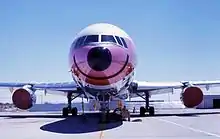
Lockheed L-1011 TriStar
In the 1960s PSA was known for the brightly colored flight attendant uniforms, with miniskirts; in the early 1970s the fashion changed to hotpants.[15] One PSA flight attendant, Marilyn Tritt, wrote a book about her tenure at the company titled Long Legs and Short Nights (ISBN 0-9649577-0-1).
Management diversified in the early 1970s into a broadcasting venture called PSA Broadcasting. Radio stations were purchased in Sacramento (96.9 KPSC later KEZC), San Jose (106.5 KEZD later KEZR), Los Angeles (107.5 KPSA later KLVE) and San Diego (102.9 KEZL now KLQV). All ran easy listening formats (hence EZ call letter combinations). The idea was to keep some of the airline's advertising dollars within the broadcasting company as well as collect some co-op (co-operative advertising) from businesses doing business with the airline. These stations were sold in the late 1970s.

Throughout PSA's lifetime, the flight attendants, with their humor, over-the-top passenger service, and sense of duty, helped to create a loyal passenger following. One flight attendant, Sandy Daniels, with the help of a frequent flyer, started the "Precious Stewardess Association". Frequent fliers would bring tasty treats to the crew, particularly on morning flights. In turn, PSA started the "Precious Passenger Association", with certificates and free drinks given to friendly and helpful passengers.
Ken Friedkin's son Tom was a PSA pilot in 1962 when the elder Friedkin died abruptly of a stroke, aged 47. A year later, Tom Friedkin's mother died, making him the largest shareholder of PSA. Tom had a seat on the Board of Directors but continued as a full-time pilot for the airline.[15]
Southwest Airlines founder Herb Kelleher studied PSA extensively and used many of the airline's ideas to form the corporate culture at Southwest, and even on early flights used the same "Long Legs And Short Nights" theme for stewardesses on Southwest flights.
PSA helped train the first class of mechanics for Southwest Airlines and lent the fledgling carrier flight manuals and other needed items.
Headquarters
PSA headquarters were a windowless gray-brown building on Harbor Drive in San Diego, California.[17][18] The building was San Diego International Airport's commuter terminal until 2015 when it was converted into administrative offices of the San Diego County Regional Airport Authority.
Accidents and incidents
- On January 15, 1969, a PSA Boeing 727-100, N973PS, collided with Cessna 182 N42242 while it was climbing to its cruising altitude. Both aircraft were in controlled airspace on the same frequency. The 727 continued on to Ontario, CA and made a safe landing. The right wing of the Cessna was damaged, so it returned to San Francisco.[19] This incident was similar to the San Diego crash of Flight 182 nine years later.
- On March 5, 1974, a PSA NAMC YS-11 training aircraft's engines failed, resulting in the aircraft crashing in the desert near Borrego Springs, California. The turboprop aircraft was doing a simulated landing stall. All of the four crew members survived the crash. The aircraft was written off.[20]
- On September 25, 1978, PSA Flight 182, a Boeing 727-200, crashed in San Diego while trying to land at Lindbergh Field (San Diego International Airport), California, after colliding with a Cessna 172 operated by Gibbs Flite Center. The 727 crashed at the intersection of Dwight and Nile. The Cessna fell a few blocks away. All 135 aboard the PSA flight were killed, as were the 2 in the Cessna and 7 on the ground. At the time, it was the deadliest plane crash in U.S. history; it remains the worst mid-air collision in the United States.[21] A lawsuit argued by Gary Aguirre resulted in a verdict against PSA for damages.[22] Graphic footage of the aftermath including destroyed houses, the wreckage itself and horrifically mutilated body parts of victims were shown in the mondo film Faces of Death, released just 2 weeks later.
- On December 7, 1987, PSA Flight 1771, a BAe 146, bound for San Francisco International Airport from Los Angeles International Airport, was airborne above the central coast of California when it suddenly entered a high-speed nosedive and crashed on a cattle ranch near the small coastal town of Cayucos in San Luis Obispo County. Investigations determined that David Burke, a former employee of USAir (which had recently acquired PSA) who had been fired for theft, had armed himself and boarded the flight, which was carrying his former manager. After writing a note on an air sickness bag, Burke then shot his ex-manager, a flight attendant, both pilots and the airline's chief pilot. After shooting the pilots, Burke pushed down on the control column, causing it to enter a dive. There were no survivors among the 43 aboard (38 passengers, 5 crew).[23]
Hijackings
There were several attempted hijackings which resulted in no injuries and the surrender of the often lone hijacker. These incidents are not included. The following are notable hijackings because of fatalities or success in forcing the aircraft to fly to another country
- On January 7, 1972, PSA 902, a Boeing 727-200 flight from San Francisco to Los Angeles was hijacked to Cuba. The captain negotiated the release of the passengers in Los Angeles and the hijackers, armed with a shotgun and other arms, were taken to Cuba,[24] with a fueling stop in Tampa where they released custody of the aircraft back to the captain. Three flight attendants and three off-duty flight attendants were not released with the passengers and accompanied the flight to Cuba.[25][26]
- On July 5, 1972, PSA Flight 710, a Boeing 737-200 flight from Sacramento to San Francisco was hijacked with demands to fly to the Soviet Union. The plane was stormed while on the ground at San Francisco, resulting in the deaths of one passenger and the two hijackers.[27] One of the passengers, who survived being shot in the back, was the actor Victor Sen Yung, best known as Hop Sing from the Bonanza television series. One other passenger was shot and survived.[28][29][30]
- On May 1, 1980, PSA Flight 818, a Boeing 727 flying from Stockton to Los Angeles was hijacked prior to passenger boarding. The hijacker demanded to be taken to Iran, but was overpowered several hours later by sole hostage Alan Romatowski, the flight engineer left on board the aircraft.[31][32][33][34]
Destinations
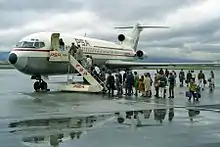
Boeing 727-100 in 1971
PSA served the following domestic destinations in the U.S. at various times during its existence.[35][36]
Arizona
California
- Arcata-Eureka Airport, Arcata/Eureka (ACV)
- Burbank-Glendale-Pasadena Airport, Burbank (BUR)
- Buchanan Field Airport, Concord (CCR)
- Fresno Yosemite International Airport, Fresno (FAT)
- Lake Tahoe Airport, South Lake Tahoe (TVL)
- Long Beach Airport, Long Beach (LGB)
- Los Angeles International Airport, Los Angeles (LAX)
- Monterey Peninsula Airport, Monterey (MRY)
- Oakland International Airport, Oakland (OAK)
- Ontario International Airport, Ontario (ONT)
- Palm Springs International Airport, Palm Springs (PSP)
- Sacramento Municipal Airport (SAC) – (all airlines serving Sacramento then moved to the then-new SMF in October 1967 and SAC was renamed Sacramento Executive Airport)
- Sacramento Metropolitan Airport, Sacramento (SMF)
- San Diego International Airport, San Diego (SAN) – home base
- San Francisco International Airport, San Francisco (SFO)
- San Jose International Airport, San Jose (SJC)
- John Wayne Airport, Santa Ana (SNA)
- Stockton Metropolitan Airport, Stockton (SCK)
Colorado
Idaho
- Boise Air Terminal, Boise (BOI)
New Mexico
Nevada
Oregon
- Eugene Airport-Mahlon Sweet Field, Eugene (EUG)
- Medford-Jackson County Airport, Medford (MFR)
- Portland International Airport, Portland (PDX)
- Redmond-Roberts Field, Redmond (RDM)
Texas
- Dallas, Texas - Love Field (DAL)
- San Antonio, Texas - San Antonio International Airport (SAT)
Utah
Washington
- Bellingham International Airport, Bellingham (BLI)
- Pasco-Tri Cities Airport, Pasco (PSC)
- Seattle-Tacoma International Airport, Seattle (SEA)
- Spokane International Airport, Spokane (GEG)
- Yakima Air Terminal, Yakima (YKM)
Mexico
PSA also served the following destinations in Mexico at various times during its existence:[37][38]
- Los Cabos (Cabo San Lucas) (SJD)
- Mazatlan (MZT)
- Puerto Vallarta (PVR)
Fleet
Final fleet
The PSA fleet at the time of its merger into USAir:[39][40]
| Aircraft | Total | Introduced | Passengers | Notes |
|---|---|---|---|---|
| British Aerospace BAe 146-100A | 1 | 1986 | 85 | Two additional examples were leased, having been returned to their respective owners prior to the USAir merger. |
| British Aerospace BAe 146-200A | 23 | 1984 | 85 | Four aircraft were delivered in 1987 while the USAir merger was in progress. |
| McDonnell Douglas DC-9-32 | 4 | 1983[lower-alpha 1] | 100 | All four aircraft were purchased used from Altair Airlines. |
| McDonnell Douglas MD-81 | 21 | 1980 | 150 | First American customer of the MD-80 series. |
| McDonnell Douglas MD-82 | 10 | 1982 | 150 |
Historic fleet
_JP5964380.jpg.webp)

The PSA fleet formerly consisted of the aircraft:[40]
| Aircraft | Total | Introduced | Retired | Notes |
|---|---|---|---|---|
| Bell 206 | 1 | 1967 | Unknown | |
| Boeing 727-100 | 16 | 1965 | 1983 | |
| Boeing 727-200 | 33 | 1968 | 1985 | |
| Boeing 737-200 | 14 | 1968 | 1976 | |
| Douglas DC-3/C-47 Skytrain | 9 | 1949 | 1955 | |
| Douglas C-54 Skymaster | 4 | 1955 | 1961 | |
| Douglas DC-6B | 1 | 1960 | 1963 | Leased from Standard Airways. Operated to Oakland while awaiting the delivery of the Lockheed Electra |
| Lockheed L-188A Electra | 4 | 1961 | 1979 | Aircraft type was introduced and retired on two separate occasions.[lower-alpha 2] |
| Lockheed L-188C Electra | 5 | 1959 | 1979 | |
| Lockheed L-1011-1 TriStar | 2[lower-alpha 3] | 1974 | 1975 | Both aircraft were briefly used for commuter service between Los Angeles and San Francisco. |
| McDonnell Douglas DC-9-31 | 1 | 1967[lower-alpha 1] | 1970 | Delivered new by McDonnell Douglas. Later sold to Ozark Airlines. |
| McDonnell Douglas DC-9-32 | 1 | 1967[lower-alpha 1] | 1969 | Delivered new by McDonnell Douglas. Later sold to Aeroméxico. |
PSA training fleet
The following aircraft were used for training only:[41][40]
| Aircraft | Total | Introduced | Retired | Notes |
|---|---|---|---|---|
| Beechcraft Model 99 | 1 | 1972 | 1975 | |
| Bell 47-G4A | 1 | Unknown | 1969 | |
| Brantly B-2 | 1 | Unknown | Unknown | |
| Beech Bonanza F33-A | 8 | Unknown | Unknown | |
| Learjet 24 | 1 | Unknown | Unknown | |
| NAMC YS-11A-202 | 1 | 1972 | 1974 | Single example was written off, following a hull loss accident caused by dual engine failure.[20] Never painted in PSA livery. |
| NAMC YS-11A-212 | 1 | 1974 | 1975 | Never painted in PSA livery. |
| Piper Aztec 23-350 | 16 | Unknown | Unknown | |
| Piper Comanche 24-260 | 5 | 1967 | Unknown | |
| Piper Aztec 28R-180 | 1 | Unknown | Unknown | |
Detailed fleet notes
- Two DC-9-30 aircraft were delivered to PSA in 1967 new. These were operated and owned, prior to the four ex-Air Canada DC-9-32 aircraft, purchased used from Altair Airlines in 1983.
- Originally, six L-188 examples were delivered new or used by Lockheed to PSA, between 1959 and 1963. The aircraft were retired in 1968 in favor of newer jet aircraft, including the Boeing 727, Boeing 737 and McDonnell Douglas DC-9. Four L-188 aircraft, including one aircraft previously owned by PSA, were purchased used or leased, between 1975 and 1977, due to jet aircraft restrictions at Lake Tahoe Airport. Due to high operating costs, service to Lake Tahoe was discontinued and the four aircraft were sold in 1979.
- A total of five L-1011-1 aircraft were initially ordered from Lockheed by PSA. The airline only accepted the delivery of two aircraft, with the examples being operated briefly as high capacity commuter aircraft. The further three examples were cancelled during production and were resold by Lockheed to LTU International.
References
- "PSA". Spokesman-Review. (Spokane, Washington). (advertisement). June 1, 1983. p. A9.
- "Southwest Airlines has a flashback – emphasis flash." Los Angeles Times. March 3, 2009. Retrieved on February 18, 2010.
- Voices of San Antonio: Herb Kelleher (Dec 2017 interview, published to YouTube on Mar 29, 2018)
- American Airlines [@AmericanAir] (September 24, 2014). "#NowArriving: Our #PSA heritage livery, bringing one of the friendliest birds in the sky to our fleet" (Tweet) – via Twitter.
-
- Trinkle, Kevin, PSA History Archived 2008-12-19 at the Wayback Machine. Retrieved June 2, 2011
- http://www.timetableimages.com, June 3, 1953, PSA timetable
- Airlift December 1959
- Aviation Week 20 January 1964, 22 February 1971
- Aviation Week 10 Apr 1967 p43, 17 July 1967 p47
- The PSA History/Olditimers Page – Lockheed L-1011 – Trinkle, Kevin; Retrieved August 24, 2010, Archived December 19, 2008, at the Wayback Machine
- "What would you call the world's quietest jetliner?". Spokesman-Review. (Spokane, Washington). (advertisement). April 10, 1984. p. A16.
- Smiliner Archived 2007-01-02 at the Wayback Machine
- Dr. Hugh Jordan OESCA Memorial Page
- "PSA's Spring SuperSmile fares..." Spokane Chronicle. advertisement. March 24, 1987. p. A9.
- Forbes Magazine: October 1, 2001-Under the Radar by Doug Donovan
- Trinkle, Kevin. "Smiles on US Airways". The PSA History Page. Retrieved January 7, 2014.
- Ray, Nancy. "Family mourns daughter who died after attending festival" Tampa Bay Times. June 2, 2016. Retrieved on September 26, 2023..
- "World Airline Directory." Flight International. March 31, 1984. 876.
- "ASN Aircraft accident Boeing 727-14 N973PS San Francisco, CA".
- ASN accident NAMC YS-11A-202 N208PA Borrego Springs, California Retrieved April 8, 2008
- ASN accident Boeing 727-214 N533PS San Diego International Airport, CA (SAN) Retrieved April 1, 2009
- Ted Vollmer, "PSA Ruled Liable for Crash Damage Claims", Los Angeles Times San Diego County edition (August 15, 1979)
- ASN Aircraft accident British Aerospace BAe-146-200 N350PS Paso Robles, CA
- ASN Aircraft accident Boeing 727 ?
- Airliner Magazine, November, 2000
- "California airliner skyjacked to Cuba". Eugene Register-Guard. (Oregon). Associated Press. January 8, 1972. p. 1A.
- ASN Aircraft accident Boeing 737-200 San Francisco International Airport, CA (SFO)
- Ada Evening News, July 6, 1972, p. 1
- Emch, Tom (September 12, 2009). "Anatomy of a Hijack". SF Chronicle and Examiner. Retrieved 1 April 2013.
- Yeager, Bob (July 6, 1972). "FBI agents foil skyjacking; 1 passenger, 2 gunmen die". Eugene Register-Guard. (Oregon). Associated Press. p. 4A.
- "ASN Aircraft accident Boeing 727 registration unknown Stockton Airport, CA (SCK)".
- "Man surrenders after seizing jet, flight engineer". Eugene Register-Guard. (Oregon). Associated Press. May 2, 1980. p. 6A.
- Beymer, Linda Jones (May 2, 1980). "Jet seized in Stockton hijack try". Lodi News-Sentinel. (California). p. 1.
- Foster, Karen (May 3, 1980). "Stockton skyjacker charged". Lodi News-Sentinel. (California). p. 1.
- "The PSA/Oldtimers Page". Archived from the original on 2008-12-19. Retrieved 2009-08-07.
- PSA Pacific Southwest Airlines bag tags
- "Pacific Southwest Airlines February 17, 1988 Route Map".
- "Ps091780".
- "Pacific Southwest Airlines (PSA) Fleet Details and History". Planespotters.net. Retrieved August 20, 2021.
- "PSA fleet". aerobernie.bplaced.net. Retrieved February 20, 2021.
- Trinkle, Kevin. "Flight Training" Archived 2012-05-19 at the Wayback Machine – The PSA History/Olditimers Page – Retrieved March 28, 2009
External links
- The PSA History Museum – Dedicated to preserving the history of PSA
- PSA-history.org – history of PSA
- Poor sailors' airline: A history of Pacific Southwest Airlines